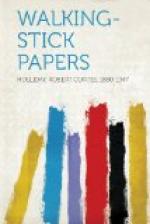As for the drama. The brightest word at night in this galaxy of ultra signs is the gracious word “Photo Play House.” Deep beyond plummet’s sound is the interest of this part of town in the human story, as revealed upon the “screen.” Grief and mirth, good and evil, danger and daring, and the horizon from Hatteras to Matapan may be scanned upon the poster boards before the entrances of these showy temples of the mighty film. Here one is invited to witness “Carmen,” and also a “drama of life,” “Tricked by a Victim,” and also “a comedy drama full of pep” entitled “Good Old Pop,” productions of the “Premier Picture Corporation.” Announcements of scenes of tornadoes, the Great War, of “Paris fashions,” and, ah, yes! of “beauty films” line the way.
To turn to the home. The people of this part of town dwell, according to their shops, entirely amid “period and art furniture.” And it would seem, by the remarkable number of places in this quarter where this is displayed for sale, that they dwell amid a most amazing amount of it. These marts of household gods are of two kinds: ones of imposing size, with long windows stretching far down the cross street, and dealing in shining “reproductions,” and the tiny, quaint, intimate, delightful kind of thing, where it is said on a sign on a gilded chair that “artistic picture hanging by the hour” is done.
The fascinating places are the more alluring. Herein rich jumbles are, of tapestries, clocks of all periods—including a harvest of those of the “grandfather” era—fire-screens, brass kettles, andirons, stained-glass, artistic lamps in endless variety, the latest things in pillow cushions, book racks, wall papers, wall “decorations” and “hangings,” draperies, curtains, cretonnes. The “decorators” deal, too, in “parquet floors,” and flourish and increase in their kind in response, evidently, to the volume of demand for “upholstering” and “cabinet work.” And the floors of this part of town must hold rich stores of Oriental rugs, as importers of these are frequent on our way.
The higher civilisations turn, naturally, to refinements of religious thought. What the Salvation Army is to Fourteenth Street, what the Rescue Mission is to the Bowery, the Christian Science Reading Room is to this stretch of Broadway, and there is no trimmer place to be seen on your stroll. Then, one of the marks of our culture to-day is the aesthetic cultivation of the primitive. Our neighbourhood is invited, on placards in windows, to assemble “every Sunday evening” to enjoy the “love stories of the Bible.”
For the rest, you would see on your stroll, for man cannot live by taste and the spirit alone, sundry places of business concerned with real estate, electrical accoutrement, automobile accessories, toys, the investment and safeguarding of treasure, and so on, and particularly with ales, wines, liquors, and cigars. Each and all of these, however, are affirmed to be “places of quality.”




